Automatic Detection of Missing Access Points in Indoor Positioning System †
Abstract
1. Introduction
2. Related Work
3. Preliminaries and Notation
3.1. Fingerprinting
- (i)
- is the set of all APs used for the localisation model enumerated by the consecutive natural numbers ().
- (ii)
- is the space of fingerprints where .For
- (a)
- the coordinates denote the horizontal location of the measurement point;
- (b)
- the coordinate denotes the floor where the measurement point is placed;
- (c)
- is the time of the measurement;
- (d)
- , where , is the RSS from the kth source from . If there is no signal from the kth AP then , where ∅ is a special unique value.
- (iii)
- A set of fingerprints defines a measurement series. Usually S is collected during one or a few consecutive days on the same set of measurement points in a particular building.
- (iv)
- is the projection onto the first three coordinates of the set and is the projection onto the last n coordinates. In other words provides us with the location of a fingerprint f while is the RSS vector associated with f (fingerprint).
- (v)
- For we denote which is the set of visible APs for the fingerprint v.
3.2. Localisation Model
- (i)
- Mean horizontal error
- (ii)
- Classification error for floor’s prediction
4. Data Sets Explained
4.1. Fingerprints
4.2. Graph
- free—the edge does not intersect any obstacle and there is a free passage along the edge.
- door—the edge intersects the door
- wall—all other cases. That includes: the edge intersects a wall or any other unmovable obstacle.
5. Self-Correcting Localisation System
5.1. Selection of Initial Signal Sources
5.1.1. Calculation of Importance
5.1.2. Selection of Learning Subset
5.2. Building Localisation Model
5.3. Detection of Infrastructure Malfunction
| Algorithm 1: DetectAP algorithm |
 |
5.4. Computation Time
6. Tests and Results
6.1. Testing Procedure
| Algorithm 2: CROWD algorithm |
 |
- (i)
- if .
- (ii)
- if .
6.2. Testing Scenarios
- 5 APs were selected and turned off.
- 5 APs were selected and turned off. However, the detection was started assuming that some other 5 APs were turned off and then turned on again. In this way we could see how fast we were able to detect that they were present.
- 10 APs were selected and turned off.
- 10 APs were selected and turned off. However, the detection was started assuming that some other 10 APs were turned off and then turned on again. In this way we could see how fast we were able to detect that they were present.
- No APs were turned off. However, people were moving only on the first and the ground floor.
- N–number of readings that need to be gathered to decide if a particular AP is missing or present. The number is the same for every AP s. However, we gathered only those readings for which the predictor predicts that there is a signal from AP s.
- K–number of people moving on paths created using CROWD procedure (Algorithm 2).
- –the decision parameter. The higher the parameter, the more likely APs are excluded from the set of APs that are used for localisation.
- –the decision parameter. The lower the parameter, the more likely APs are included in of APs that are used for localisation.
6.2.1. Scenario 1
6.2.2. Scenario 2
6.2.3. Scenario 3
6.2.4. Scenario 4
6.2.5. Scenario 5
6.2.6. Scenario 1 and 2 for 30 People Moving Inside the Building
6.3. Comparison with Other Approach
7. Conclusions and Future Works
Author Contributions
Funding
Acknowledgments
Conflicts of Interest
References
- Jiang, T.; Yang, X.; Cui, X. Performance Enhancement of Indoor Pedestrian Positioning with Two-Order Bayesian Estimation Based on EKF and PF. Symmetry 2017, 9, 91. [Google Scholar] [CrossRef]
- Lee, M.S.; Ju, H.; Park, C.G. Map assisted PDR/Wi-Fi fusion for indoor positioning using smartphone. Int. J. Control Autom. Syst. 2017, 15, 627–639. [Google Scholar] [CrossRef]
- Chiang, K.W.; Liao, J.K.; Huang, S.H.; Chang, H.W.; Chu, C.H. The Performance Analysis of Space Resection-Aided Pedestrian Dead Reckoning for Smartphone Navigation in a Mapped Indoor Environment. ISPRS Int. J. Geo-Inf. 2017, 6, 43. [Google Scholar] [CrossRef]
- Racko, J.; Brida, P.; Perttula, A.; Parviainen, J.; Collin, J. Pedestrian Dead Reckoning with Particle Filter for handheld smartphone. In Proceedings of the 2016 International Conference on Indoor Positioning and Indoor Navigation (IPIN), Alcala de Henares, Spain, 4–7 October 2016; pp. 1–7. [Google Scholar] [CrossRef]
- Górak, R.; Luckner, M.; Okulewicz, M.; Porter-Sobieraj, J.; Wawrzyniak, P. Indoor Localisation Based on GSM Signals: Multistorey Building Study. Mob. Inf. Syst. 2016, 2016, 2719576. [Google Scholar] [CrossRef]
- Tuta, J.; Juric, M.B. A Self-Adaptive Model-Based Wi-Fi Indoor Localization Method. Sensors 2016, 16, 2074. [Google Scholar] [CrossRef] [PubMed]
- Breiman, L. Random Forests. Mach. Learn. 2001, 45, 5–32. [Google Scholar] [CrossRef]
- Tang, D.B.; Ye, M.; Chen, Y.K. An Improved Weighted K Nearest Neighbors Algorithm for WLAN Localization. Materials Processing and Manufacturing III. Trans Tech Publications. Adv. Mater. Res. 2013, 753, 2191–2195. [Google Scholar] [CrossRef]
- Kanaris, L.; Kokkinis, A.; Liotta, A.; Stavrou, S. Fusing Bluetooth Beacon Data with Wi-Fi Radiomaps for Improved Indoor Localization. Sensors 2017, 17, 812. [Google Scholar] [CrossRef] [PubMed]
- Ding, H.; Zheng, Z.; Zhang, Y. AP weighted multiple matching nearest neighbors approach for fingerprint-based indoor localization. In Proceedings of the 2016 Fourth International Conference on Ubiquitous Positioning, Indoor Navigation and Location Based Services (UPINLBS), Shanghai, China, 2–4 November 2016; pp. 218–222. [Google Scholar] [CrossRef]
- Torteeka, P.; Chundi, X. Indoor positioning based on Wi-Fi Fingerprint Technique using Fuzzy K-Nearest Neighbor. In Proceedings of the 2014 11th International Bhurban Conference on Applied Sciences Technology (IBCAST), Islamabad, Pakistan, 14–18 January 2014; pp. 461–465. [Google Scholar] [CrossRef]
- Umair, M.Y.; Ramana, K.V.; Dongkai, Y. An enhanced K-Nearest Neighbor algorithm for indoor positioning systems in a WLAN. In Proceedings of the 2014 IEEE Computers, Communications and IT Applications Conference, Beijing, China, 20–22 October 2014; pp. 19–23. [Google Scholar] [CrossRef]
- Górak, R.; Luckner, M. Malfunction Immune Wi-Fi Localisation Method. In Proceedings of the 7th International Conference: Computational Collective Intelligence, Madrid, Spain, 21–23 September 2015; pp. 328–337. [Google Scholar]
- Górak, R.; Luckner, M. Modified Random Forest algorithm for Wi-Fi Indoor Localization System. In Proceedings of the 8th International Conference: Computational Collective Intelligence, Halkidiki, Greece, 28–30 September 2016; pp. 147–157. [Google Scholar]
- Gu, Y.; Lo, A.; Niemegeers, I. A survey of indoor positioning systems for wireless personal networks. IEEE Commun. Surv. Tutor. 2009, 11, 13–32. [Google Scholar] [CrossRef]
- He, S.; Chan, S.H.G. Wi-Fi Fingerprint-Based Indoor Positioning: Recent Advances and Comparisons. IEEE Commun. Surv. Tutor. 2016, 18, 466–490. [Google Scholar] [CrossRef]
- Fang, S.H.; Lin, T.N. Indoor location system based on discriminant-adaptive neural network in IEEE 802.11 environments. IEEE Trans. Neural Netw. 2008, 19, 1973–1978. [Google Scholar] [CrossRef] [PubMed]
- Belmonte-Hernández, A.; Hernández-Peñaloza, G.; Álvarez, F.; Conti, G. Adaptive Fingerprinting in Multi-Sensor Fusion for Accurate Indoor Tracking. IEEE Sens. J. 2017, 17, 4983–4998. [Google Scholar] [CrossRef]
- Zou, H.; Zhou, Y.; Jiang, H.; Huang, B.; Xie, L.; Spanos, C. Adaptive Localization in Dynamic Indoor Environments by Transfer Kernel Learning. In Proceedings of the Wireless Communications and Networking Conference (WCNC), San Francisco, CA, USA, 19–22 March 2017; pp. 1–6. [Google Scholar]
- Cai, S.; Liao, W.; Luo, C.; Li, M.; Huang, X.; Li, P. CRIL: An Efficient Online Adaptive Indoor Localization System. IEEE Trans. Veh. Technol. 2017, 66, 4148–4160. [Google Scholar] [CrossRef]
- Nevat, I.; Peters, G.W.; Avnit, K.; Septier, F.; Clavier, L. Location of Things: Geospatial Tagging for IoT Using Time-of-Arrival. IEEE Trans. Signal Inf. Process. Over Netw. 2016, 2, 174–185. [Google Scholar] [CrossRef]
- Batstone, K.; Oskarsson, M.; Åström, K. Robust time-of-arrival self calibration with missing data and outliers. In Proceedings of the 24th European Signal Processing Conference EUSIPCO, Budapest, Hungary, 29 August–2 September 2016; pp. 2370–2374. [Google Scholar] [CrossRef]
- Batstone, K.; Oskarsson, M.; Åström, K. Robust time-of-arrival self calibration and indoor localization using Wi-Fi round-trip time measurements. In Proceedings of the IEEE International Conference on Communication ICC, Kuala Lumpur, Malaysia, 23–27 May 2016; pp. 26–31. [Google Scholar] [CrossRef]
- Hoene, C.; Willmann, J. Four-way TOA and software-based trilateration of IEEE 802.11 devices. In Proceedings of the IEEE 19th International Symposium on Personal, Indoor and Mobile Radio Communications PIMRC, Cannes, France, 15–18 September 2008; pp. 1–6. [Google Scholar] [CrossRef]
- Ma, L.; Li, J.; Xu, Y.; Meng, W. Radio Map Recovery and Noise Reduction Method for Green WiFi Indoor Positioning System Based on Inexact Augmented Lagrange Multiplier Algorithm. In Proceedings of the 2015 IEEE Global Communications Conference GLOBECOM, San Diego, CA, USA, 6–10 December 2015; pp. 1–5. [Google Scholar] [CrossRef]
- Zhao, C.; Yu, T.; Tian, X.; Yu, H.; Gan, X.; Wang, X. A 3-D RSS distribution model based on statistical properties for indoor localization systems. In Proceedings of the 2015 IEEE/CIC International Conference on Communications in China, Shenzhen, China, 2–4 November 2015; pp. 1–6. [Google Scholar] [CrossRef]
- Saleem, F.; Wyne, S. Wlan–Based Indoor Localization Using Neural Networks. J. Electr. Eng. 2016, 67, 299–306. [Google Scholar] [CrossRef]
- Karwowski, J.; Okulewicz, M.; Legierski, J. Application of Particle Swarm Optimization Algorithm to Neural Network Training Process in the Localization of the Mobile Terminal. In Engineering Applications of Neural Networks; Springer: Berlin/Heidelberg, Germany, 2013; pp. 122–131. [Google Scholar] [CrossRef]
- Grzenda, M. On the Prediction of Floor Identification Credibility in RSS-Based Positioning Techniques. In Recent Trends in Applied Artificial Intelligence, 26th International Conference on Industrial, Engineering and Other Applications of Applied Intelligent Systems; Springer: Berlin/Heidelberg, Germany, 2013; pp. 610–619. [Google Scholar] [CrossRef]
- Okulewicz, M.; Bodzon, D.; Kozak, M.; Piwowarski, M.; Tenderenda, P. Indoor Localization of a Moving Mobile Terminal by an Enhanced Particle Filter Method. In International Conference on Artificial Intelligence and Soft Computing; Rutkowski, L., Korytkowski, M., Scherer, R., Tadeusiewicz, R., Zadeh, L.A., Zurada, J.M., Eds.; Springer: Berlin/Heidelberg, Germany, 2016; pp. 512–522. [Google Scholar] [CrossRef]
- Korbel, P.; Wawrzyniak, P.; Grabowski, S.; Krasinska, D. LocFusion API–Programming interface for accurate multi-source mobile terminal positioning. In Proceedings of the Computer Science and Information Systems (FedCSIS), Krakow, Poland, 8–11 September 2013; pp. 819–823. [Google Scholar]
- Rokach, L.; Maimon, O. Classification Trees. In Data Mining and Knowledge Discovery Handbook; Springer: Boston, MA, USA, 2009. [Google Scholar]
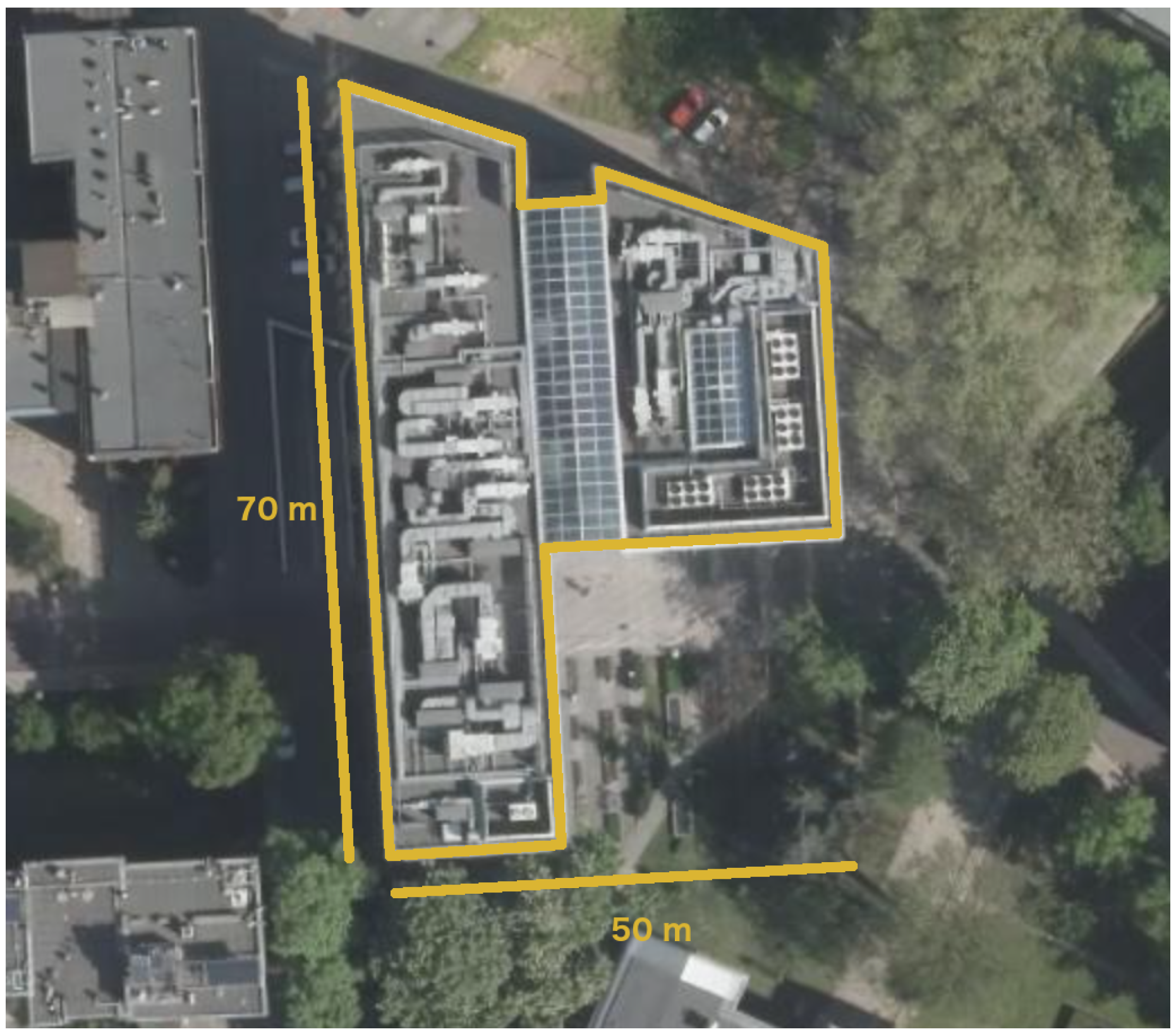
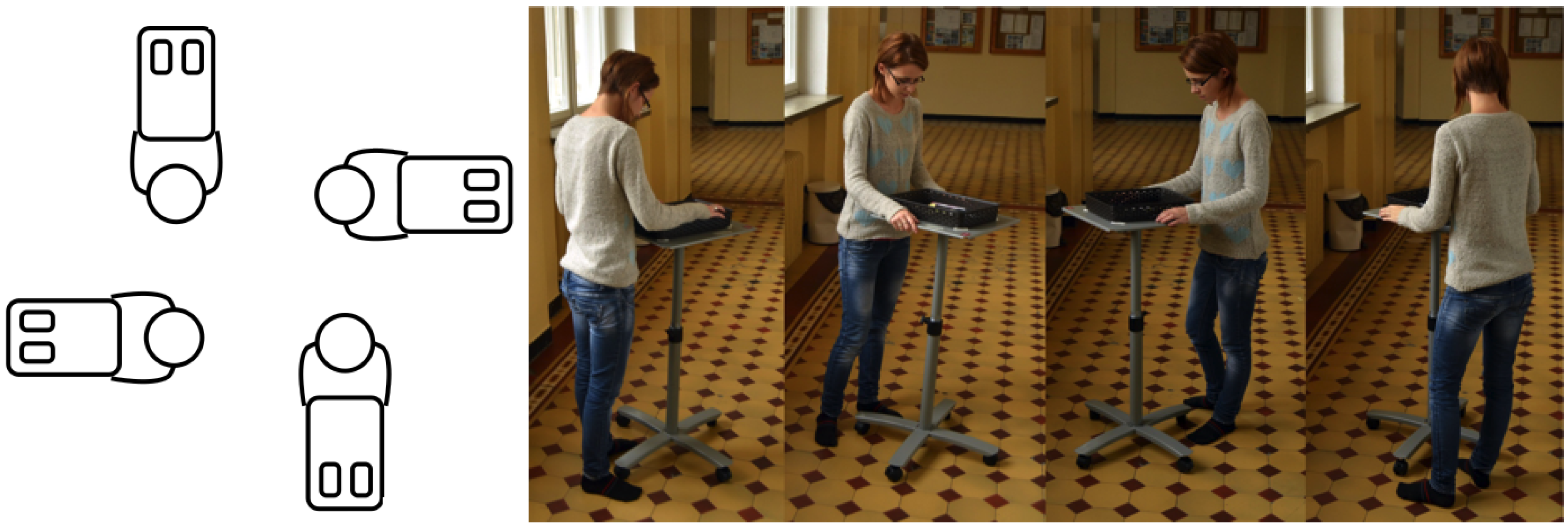
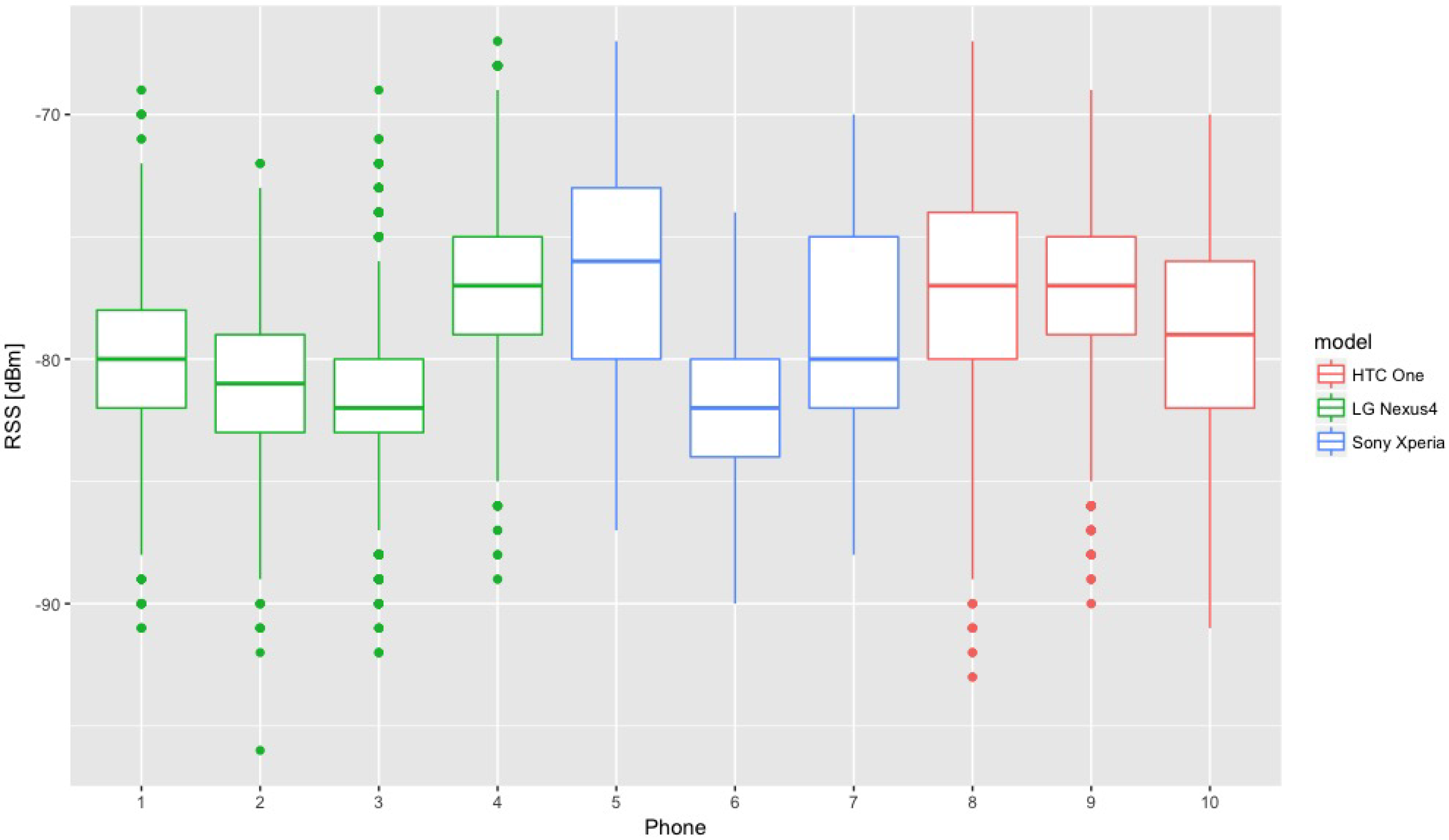
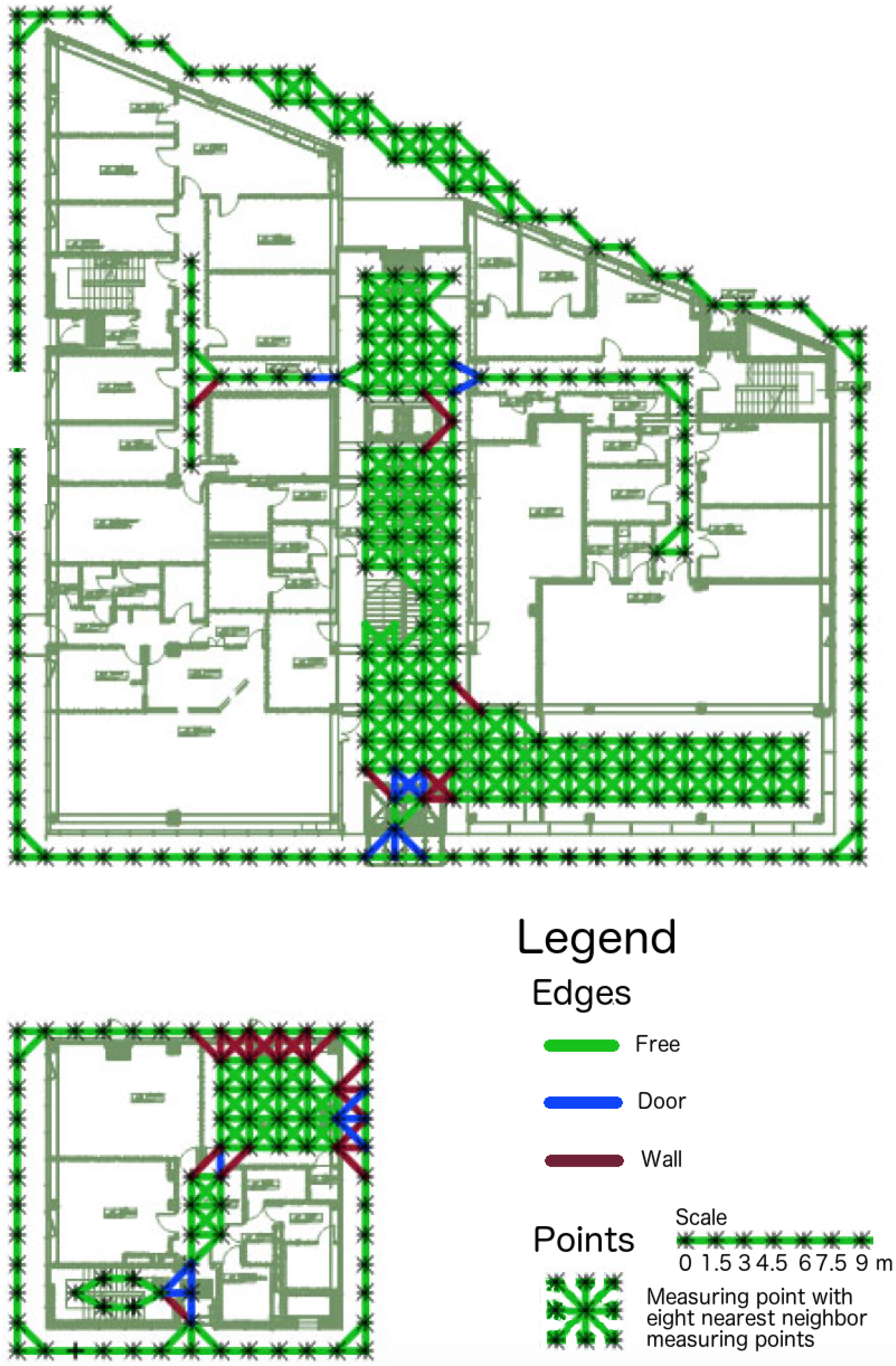
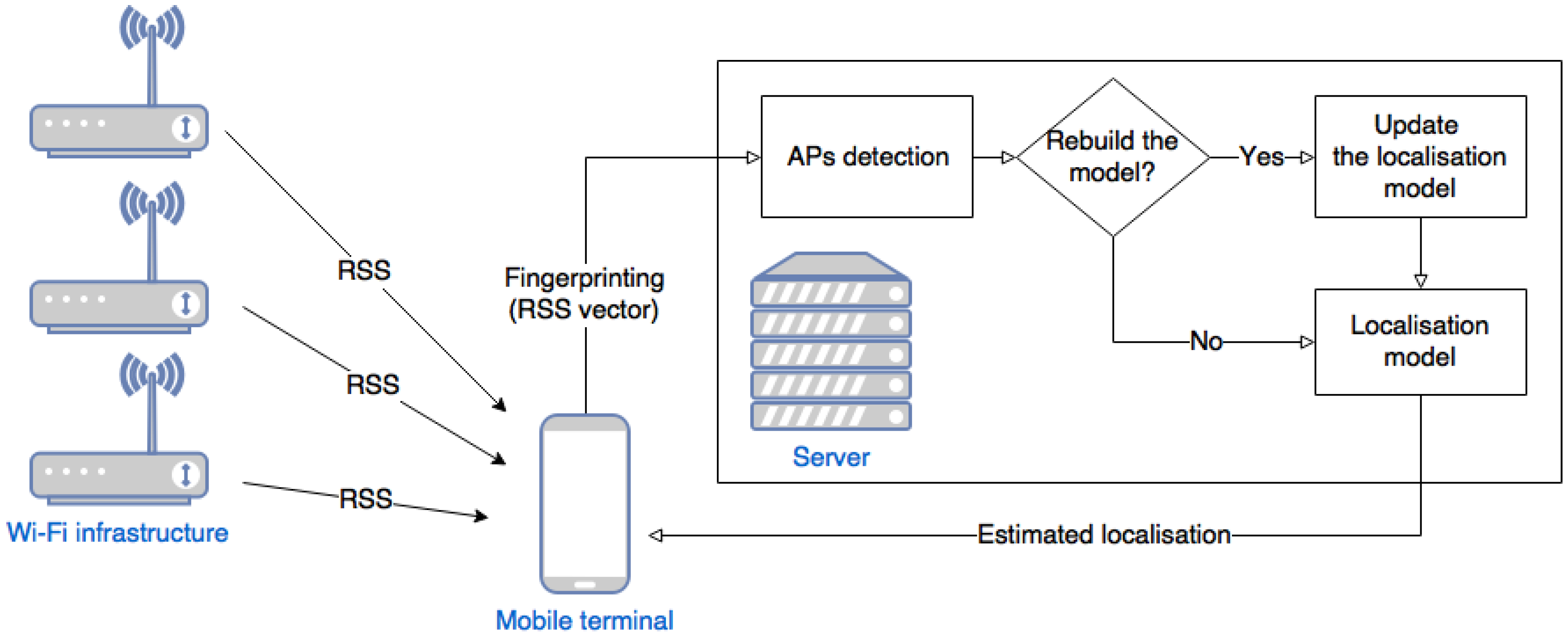
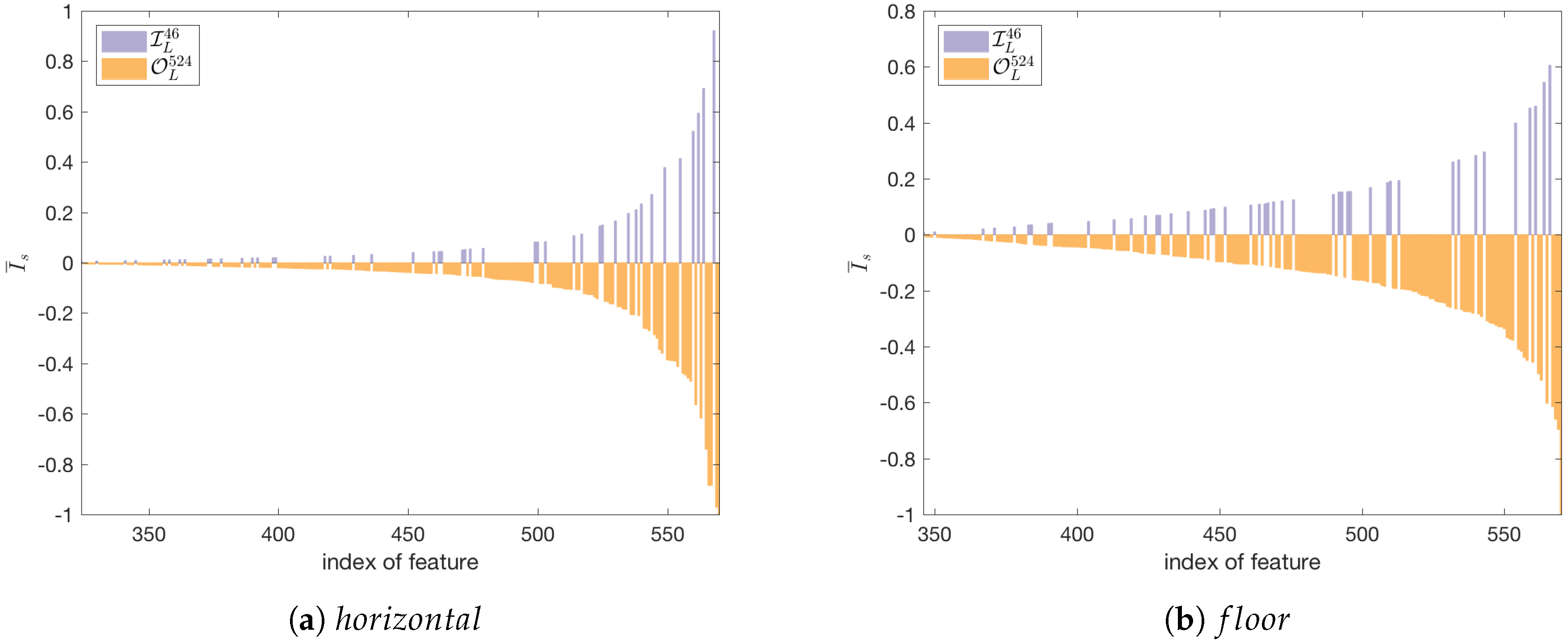
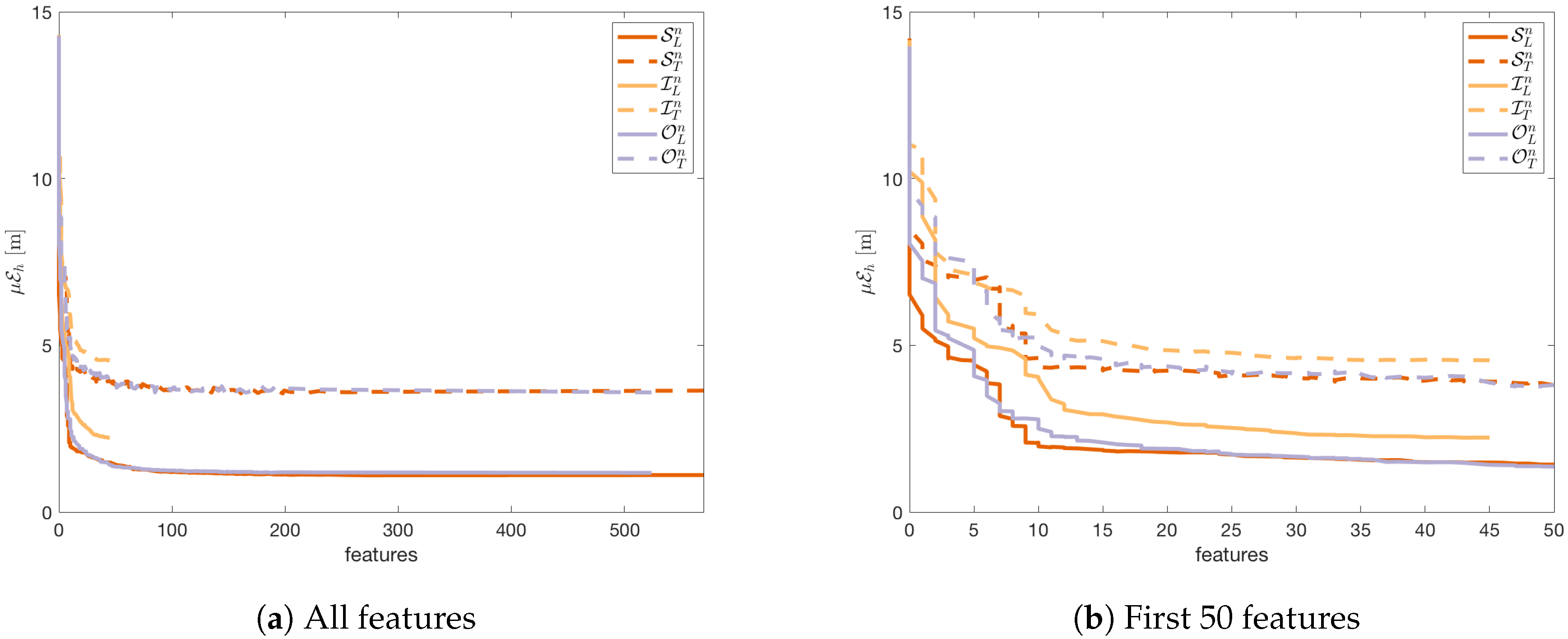
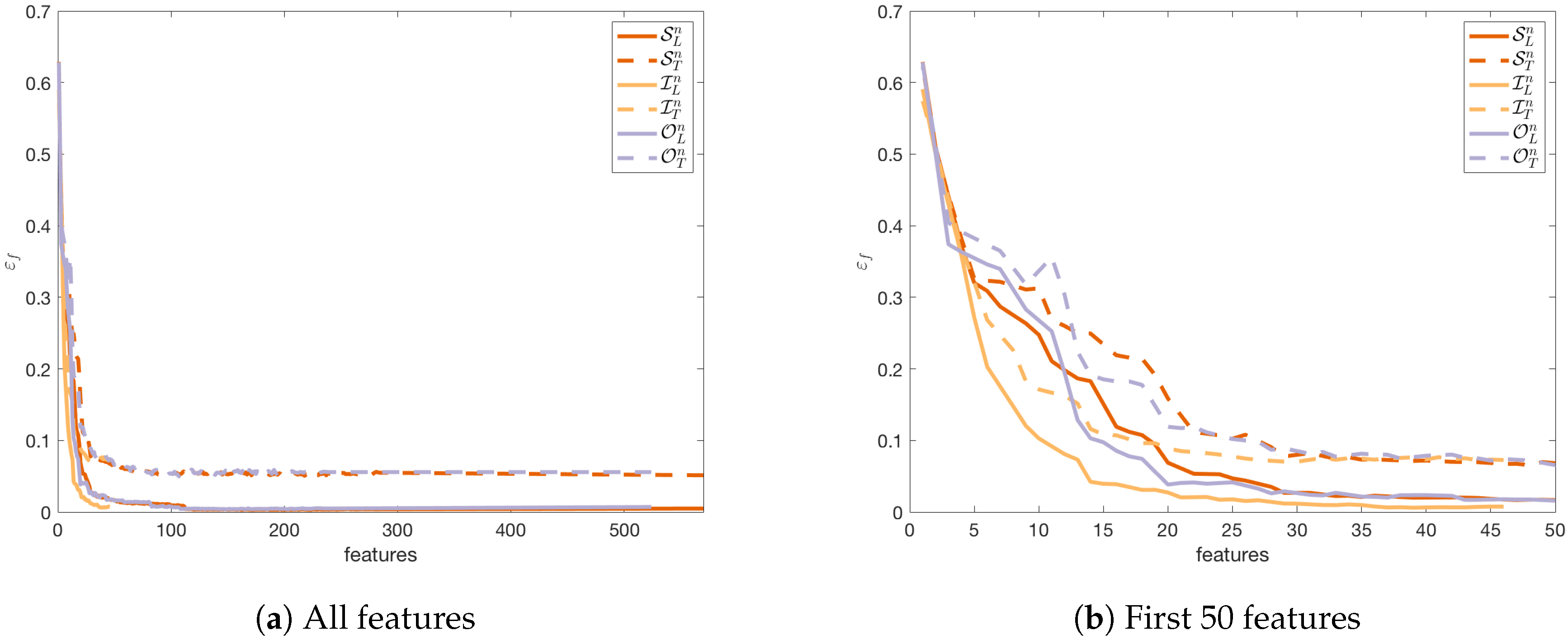

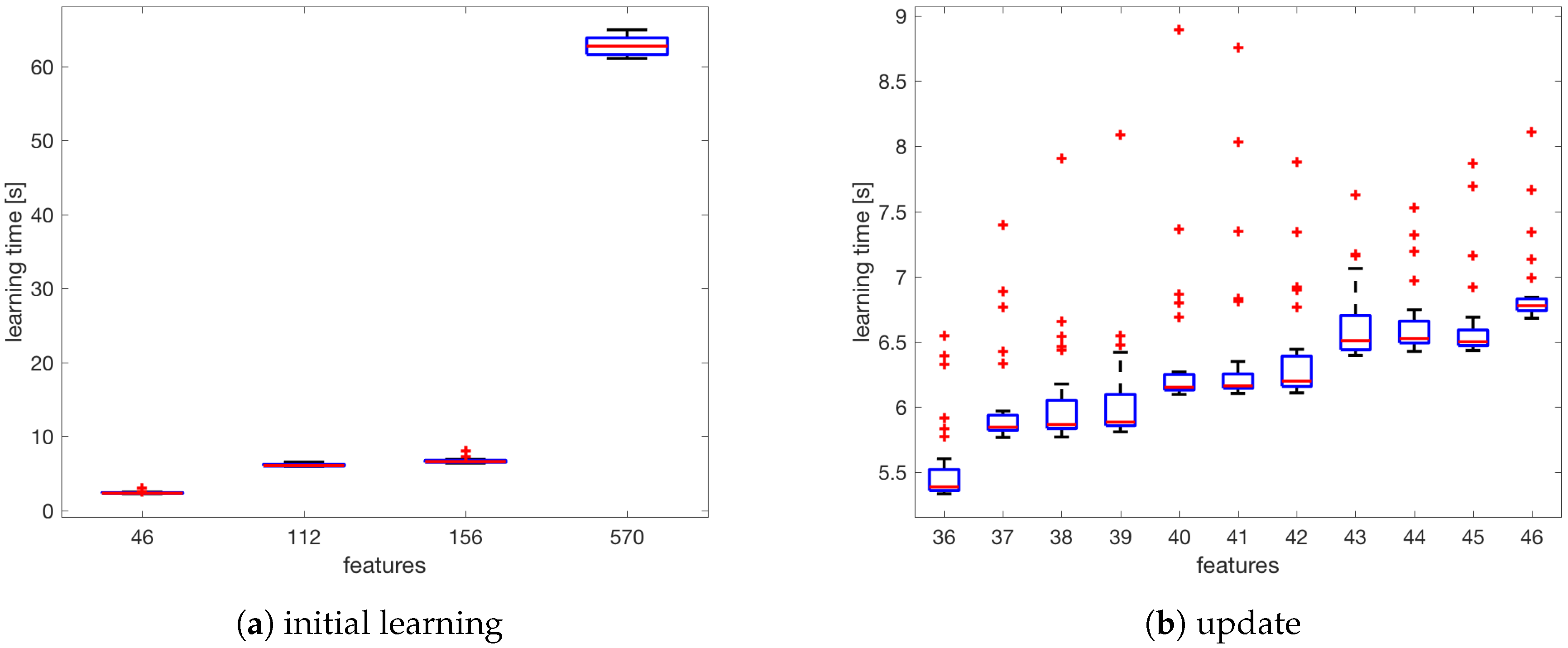
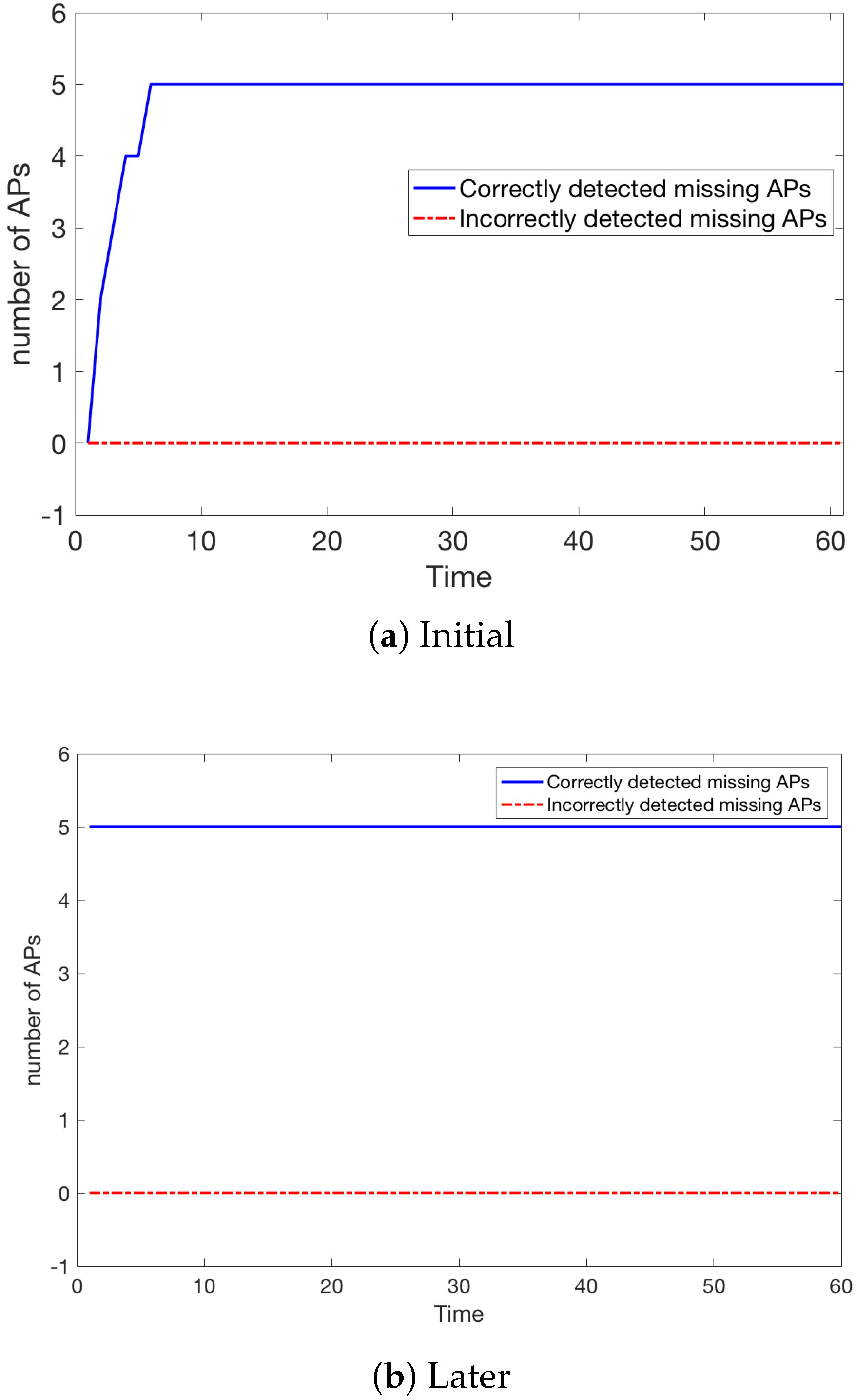
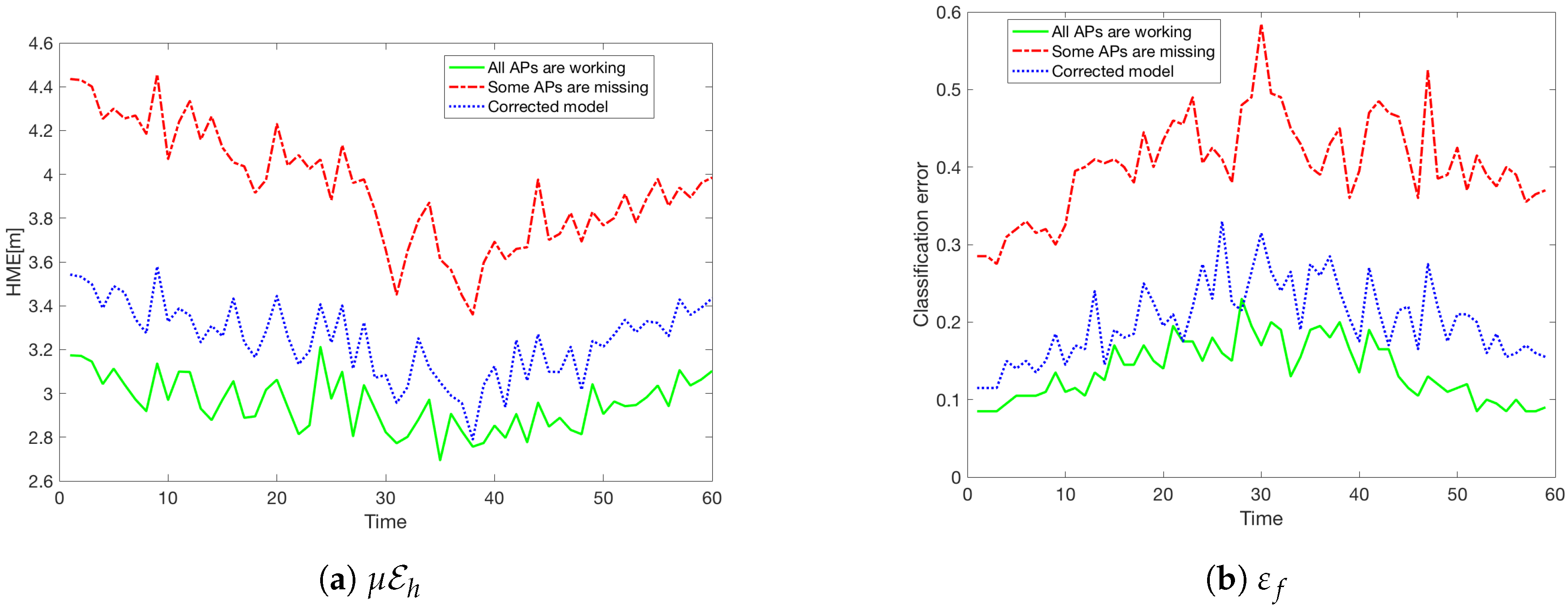
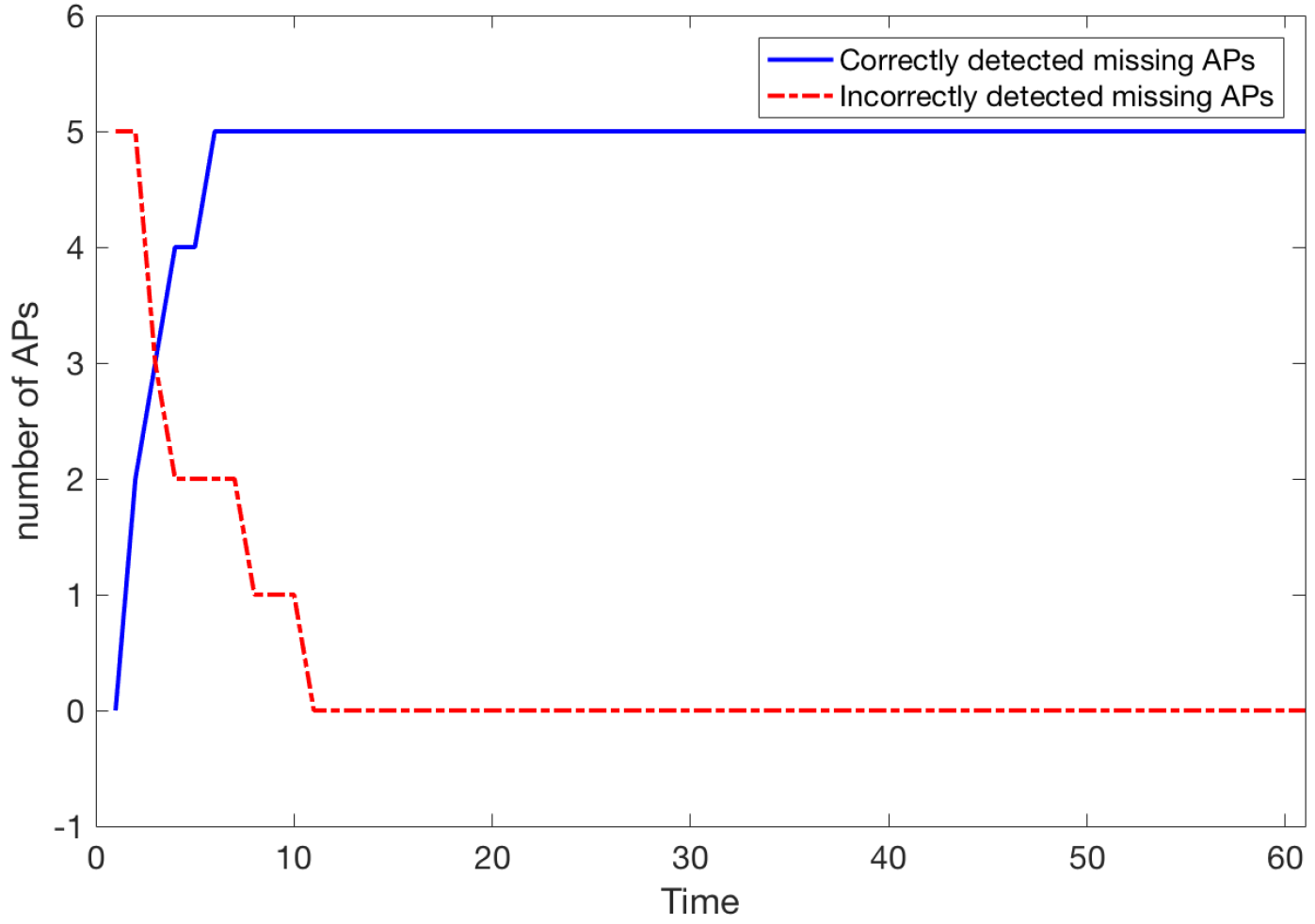
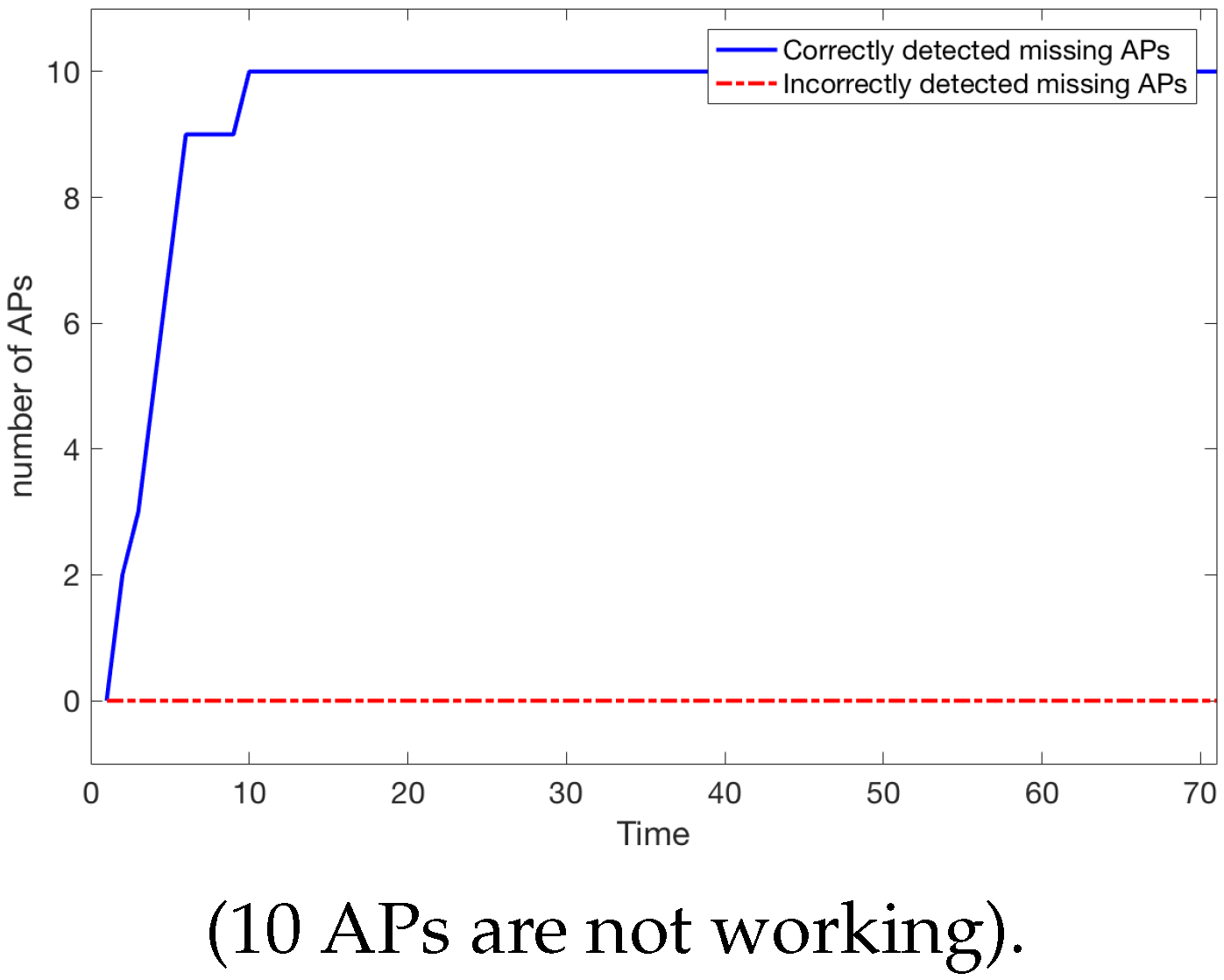
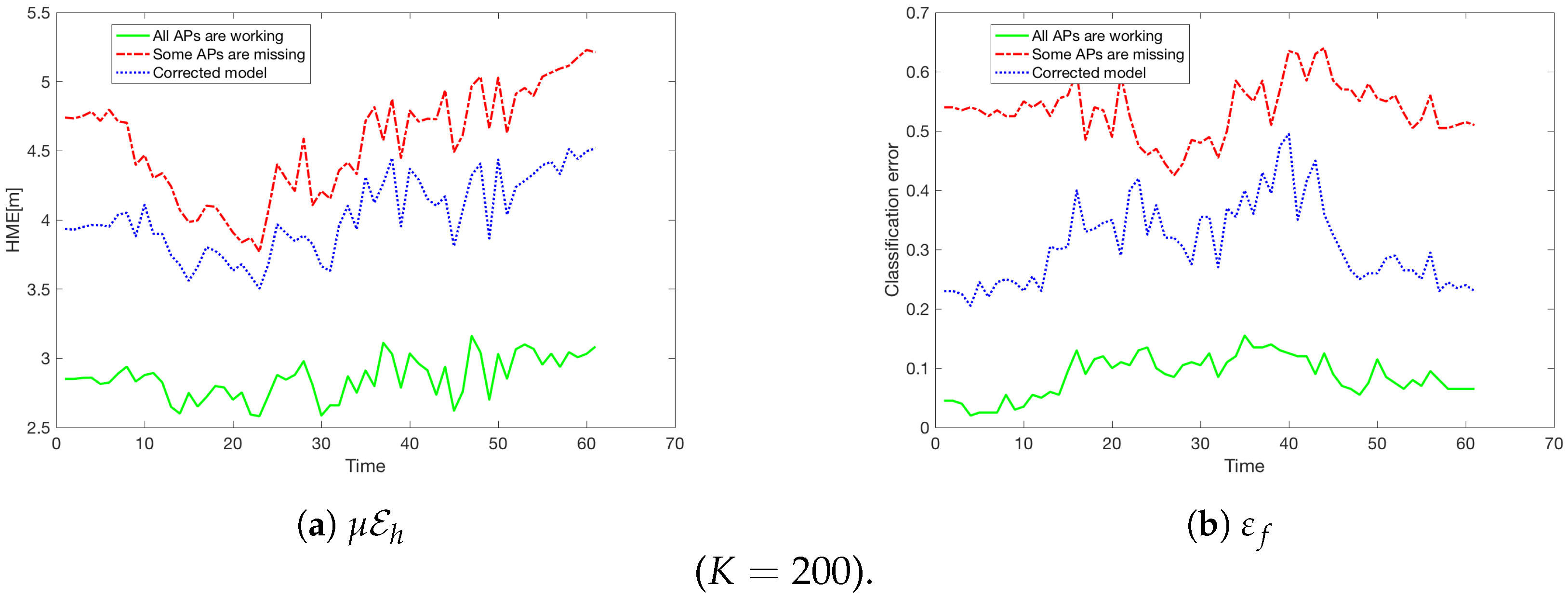

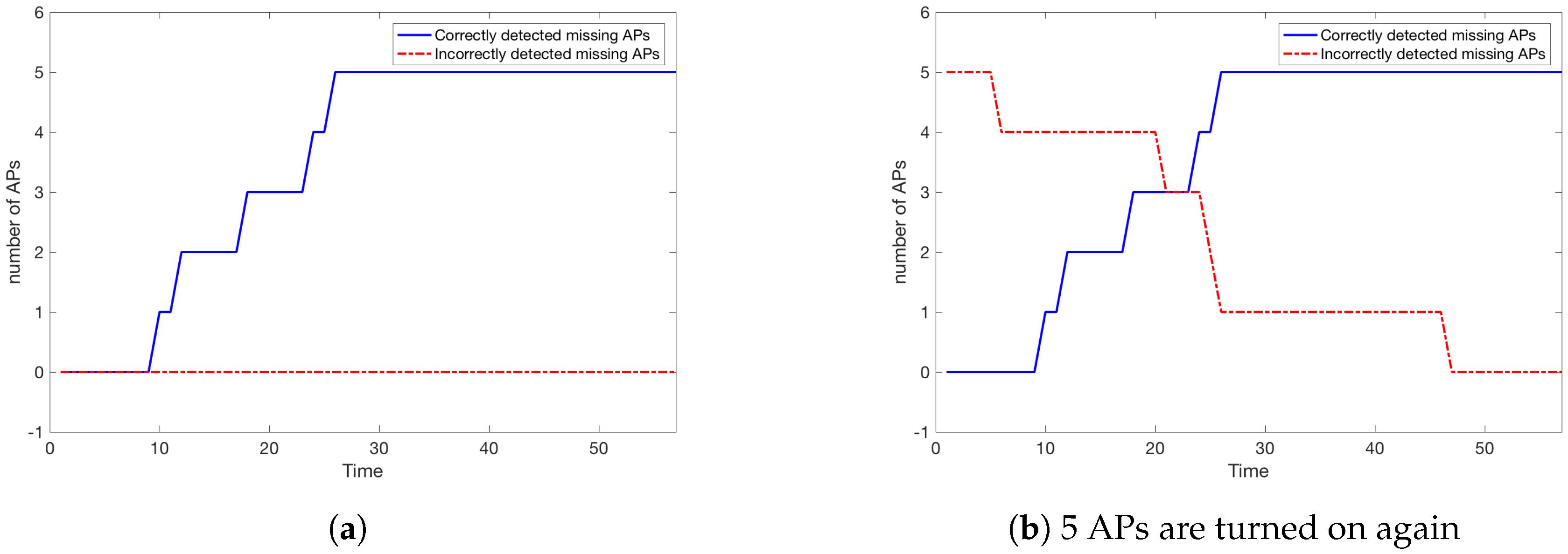
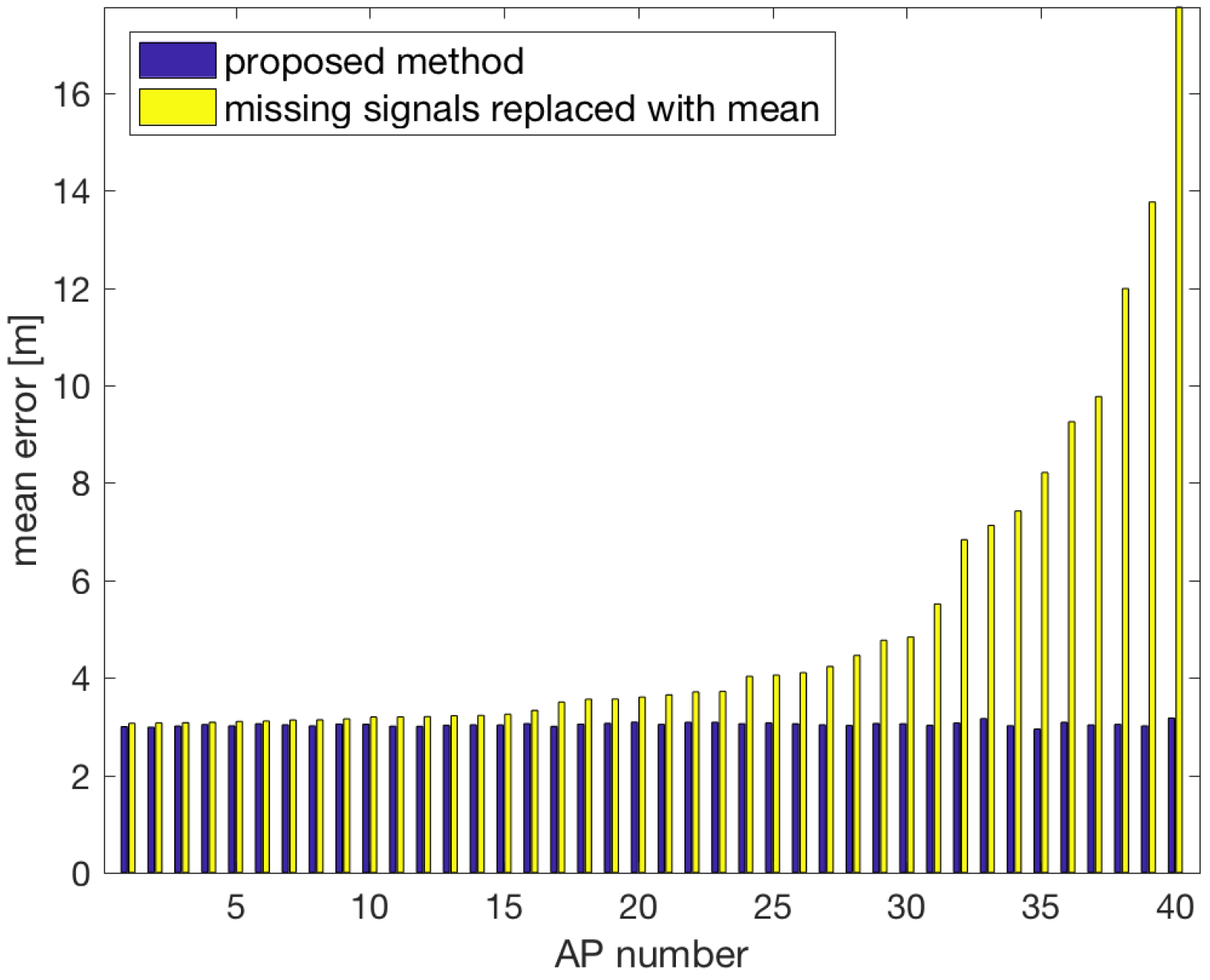
| 43680 | 46760 |
| Removed | [m] | [m] | ||
|---|---|---|---|---|
| APs | before | after | before | after |
| 0 | 4.47 | 4.47 | 0.93 | 0.93 |
| 1 | 4.74 | 4.47 | 0.91 | 0.93 |
| 2 | 5.93 | 4.72 | 0.85 | 0.92 |
| 3 | 6.77 | 4.94 | 0.81 | 0.92 |
| 4 | 7.36 | 5.07 | 0.78 | 0.92 |
| 5 | 7.80 | 5.17 | 0.73 | 0.92 |
| 6 | 8.09 | 5.34 | 0.71 | 0.91 |
| 7 | 9.36 | 5.50 | 0.69 | 0.90 |
| 8 | 10.66 | 5.98 | 0.68 | 0.90 |
| 9 | 11.13 | 6.12 | 0.65 | 0.89 |
| 10 | 11.95 | 6.41 | 0.63 | 0.89 |
© 2018 by the authors. Licensee MDPI, Basel, Switzerland. This article is an open access article distributed under the terms and conditions of the Creative Commons Attribution (CC BY) license (http://creativecommons.org/licenses/by/4.0/).
Share and Cite
Górak, R.; Luckner, M. Automatic Detection of Missing Access Points in Indoor Positioning System †. Sensors 2018, 18, 3595. https://doi.org/10.3390/s18113595
Górak R, Luckner M. Automatic Detection of Missing Access Points in Indoor Positioning System †. Sensors. 2018; 18(11):3595. https://doi.org/10.3390/s18113595
Chicago/Turabian StyleGórak, Rafał, and Marcin Luckner. 2018. "Automatic Detection of Missing Access Points in Indoor Positioning System †" Sensors 18, no. 11: 3595. https://doi.org/10.3390/s18113595
APA StyleGórak, R., & Luckner, M. (2018). Automatic Detection of Missing Access Points in Indoor Positioning System †. Sensors, 18(11), 3595. https://doi.org/10.3390/s18113595





